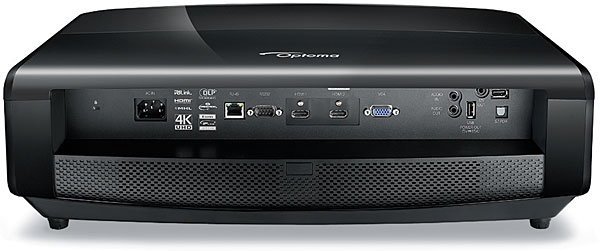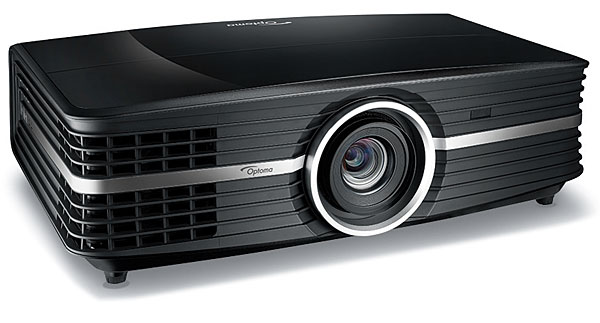The UHD65 falls short on three counts.
No 3D is a huge downfall.
Poor black levels, and so-so contrast negate the detailed picture quality that the UHD65 produces with 4k source material.
A much better option is the Epson UB5040. Its shift based technology reproduces very good faux 4k, along with excellent 3D. It has a fantastic lens and a boat full of great features.
For those who are in the market for a true 4k projector the only somewhat affordable option is the new Sony VW285ES.
Unfortunately at $5,000 is double the price of the Optoma and the Epson (both at $2,500).
Optoma UHD65 4K DLP Projector Review

AT A GLANCE
Plus
Superb resolution in HD and UHD
Effective HDR for a projector
Affordable price
Minus
Poor contrast and black level
HDR color banding
THE VERDICT
If pure picture quality with 1080p standard dynamic range will dominate your viewing there are better options out there at this price and lower. But none of them will do what the Optoma can: accept a 4K input, provide a reasonable facsimile of high dynamic range, and offer picture detail challenged only by native 4K projectors costing many times its price.
Optoma has been in the projector business for years. Go to the company’s website, and you’ll see a bewildering array of models. But the UHD65 is one of the first models to make use of a new 4K DMD (Digital Micromirror Device), the core of Texas Instruments’ Digital Light Processing technology. And along with its sister model, the UHD60, it’s one of the cheapest.
The latest TI chip is actually 2716 x 1528, which isn’t native 4K (or the 3840 x 2160 UHD resolution that dominates the consumer world).But when it’s combined with pixel shifting—first displaying half of the pixels in a 4K source, then shifting the pixels in a slightly diagonal direction and displaying the other half—all of the roughly 8 million pixels in a 4K image are flashed on the screen. The timing of the shift is so rapid that the eye blends the two “frames” together. (See "Is DLP’s 4K Really 4K?".)
This differs from the similar shifting technique that JVC and Epson use in their LCOS and LCD “4K” projectors. Those designs use 1920 x 1080 chips. Do the math, rounding off to the nearest million, and you get 2 million pixels on the screen before the shift, then 4 million after. With TI’s new 2176 x 1528 chip, the results are4 million pixels before the shift and8 million after.
It’s important to understand that for a shift using 1920 x 1080 chips, the total number of pixels must be downconverted, before being displayed, from the native 8 million to 4 million. The video processing used for this downconversion might be done well (and in our experience, it is), but you don’t get all of the original 8 million pixels on the screen. The TI chip, together with shifting, displays them all, though not at the same time. Optoma refers to a projector withthis chip as providing 4K Ultra High Definition, a claim you might deem to be correct or dubious, depending on your point of view. But, its ability tohit that 8 million pixel threshold is what officially qualifies it as a 4K display by the Consumer Technology Association.
Features
Both the UHD65 ($2,500) and its less expensive stablemate, the UHD60 ($2,000), include TI’s new chip. But the UHD65 differs in four significant ways. It has a lower claimed light output (2,200 lumens, as opposed to 3,000 forthe UHD60); it offers PureMotion, Optoma’s motion-smoothing feature (the UHD60 doesn’t); it has a black case (the UHD60’s is white); and, perhaps most important, it has an RGBRGB color wheel (instead ofthe UHD60’s RGBW). The clear segment (W) of the other projector’s color wheel is likely the reason for that model’s higher light output, but it might also result in more visible rainbows and less saturated colors at high brightness levels. (To befair, we didn’t have a UHD60 onhand to confirm either of those potential concerns.) Neither projector offers 3D.
For newbies unfamiliar with the concept of a color wheel: Most DLP projectors, and certainly all affordable ones, use a single DLP chipand a rapidly rotating color wheel. This provides the primary colorsthat are handled by three separate chips in LCD, LCOS, and multi-chip DLP designs. I did see rainbows occasionally in my viewing (not everyone is sensitive to them), mainly on bright highlights against dark backgrounds. But I found them to be less frequent and annoying than what I’ve experienced from single-chip DLP projectors in the past.
The UHD65’s zoom, focus, and lens shift are all manual. The lens shift has the most serious limitation. It’s vertical only, and when you combine that fact with the projector’s high throw angle, you’ll find you can’t position the unit on a table unless the bottom of your screen is very high off the floor. Such an arrangement can work well for a ceiling mount with the projector inverted. But before you buy, take a good look at your desired screen height, screen size, projector-to-screen distance, and projector mounting height. Professional help is recommended to ensure that all of these elements fit together.
Stray light from the UHD65 was visible on my non-flat ceiling withthe projector inverted. This wasn’ta distraction for me; my ceiling iswell over 8 feet high where the light hits it. But on a lower ceiling, this could be an issue.
Of the two HDMI inputs, onlythe second is HDCP 2.2 compliant, has MHL capability, and is said tobe capable of 4K/60 hertz. The projector’s operating frequency is 60 Hz due to the inherent requirementof the DMD signal processing; to display 24-Hz material (which includes all standard Blu-rays and nearly every Ultra HD Blu-ray), it must first do 3:2 pulldown to convert 24Hz to 60 Hz. And for the projector to display the only 60-Hz UHD Blu-ray currently available, Billy Lynn’s Long Halftime Walk, I had to use a short, 6-foot HDMI cable to ensure a solid data connection for the higher-bandwidth signal. For everything else, I used a 15-foot cable for my sources—either a test pattern generator or an Oppo UDP-203 UHD Blu-ray player.

One of the odd additions to this projector’s input/output offerings is an S/PDIF optical digital output. This can loop audio from the projector’s HDMI input to an external sound system, similar to the optical outputs provided on flat-screen TVs. This might be useful in a temporary setup, though the optical out from a disc player being used as the source would do the same thing. The UHD65 also has its own rudimentary stereo audio system. For most home theater setups,this is best left silent.
The Optoma has controls on the case, but apart from the manual lens adjustments, you’ll interface with the projector primarily through its remote control. I found it a bit too small for comfort (and for keeping it out of the seat cushions!), and it isn’t backlit. Otherwise, it’s perfectly serviceable.
The UHD65 employs a traditional UHP projection lamp. Its cooling fan is very quiet, even in Bright mode, and the cool-down time on shutoff is so brief (by my count, eight Mississippis) that I wondered if it was long enough to be effective.
Lamp life is spec’d at 4,000 hours in Bright mode, 10,000 hours in Eco, and 15,000 hours in Dynamic. In this case, Dynamic refers to the projector’s Dynamic Black control. When you engage this feature, the Brightness Mode control—which allows you to select between the Bright and Eco modes—is inaccessible. These are shockingly high lamp-life claims, but there’s no mention of whether they refer to half brightness (the usual standard) or total failure. Replacement lamps aren’t cheap—$300 to $400 is common. As with most other projector makers, Optoma’s sales are dominated by business applications, and these lamp-life numbers will appeal to CFOs. It’s unlikely that videophiles will find the projector’s performance acceptable at anywhere near these lamp-hours. We don’t run lamp-life tests, but you should start thinking about buying a new lampin as little as 1,000 hours with any lamp-based projector. The presence of HDR, which dictates that available brightness is king, makes this even more significant.
The Optoma offers nearly all the controls you’d expect in a modern projector, and a few you wouldn’t. They’re well covered in the 60-page owner’s manual, which is included on a CD-ROM and also downloadable from Optoma’s website. You can choose from among seven Display (Picture) modes. There are also two ISF modes (Day and Night) that a calibrator can bring up with a special code and then lock after the calibration is complete. RGB Gain/Bias (high/low) controls adjust white balance (there are no 10- or 20-step white balance controls), and a color management system (CMS) is provided as well to tweak the primary and secondary colors. But to use separate settings of these controlsfor different Display modes, youmust choose different settings for Color Gamut—a separate control with five options.
BrilliantColor, a feature developed by TI for DLP displays, added a little pop and dimensionality to the picture. (It actually affects luminance more than color.) UltraDetail enhances sharpness without obvious side effects on normal program material when used at level 1 or 2. Measurement purists may not wantto use it at all, however, as it shows clearly visible artifacts (if only on sharpness patterns). A Dynamic Range menu provides an HDR effect on SDR sources, but for me it produced dark images with unnaturally saturated color.

The projector has no iris of any kind, either static or dynamic. The Dynamic Black feature referenced earlier actively modulates the lamp brightness as suggested by the picture, in an effort to improve contrast. Sometimes, it did appear to make that improvement, but I found it unstable on measurements. While it appeared to darken the black levelon measurements, its effect on real program material was to alter the color and gamma without significantly affecting the visible contrast. I left it off for all of my calibrations and serious viewing.
A PureEngine menu includes PureContrast (which I did find useful), PureColor (five levels), and Pure-Motion (three levels). In its lowest setting, PureMotion produced aless melodramatic soap-operaeffect than most such controls, though I still preferred to leave it off. There’s also a PureMotion Demo feature that lets you see its effecton a split screen.
Perhaps the oddest control on the projector is Wall Color, which gives you seven colors that are supposed to compensate for different screen colors (obviously intended for projection onto an existing wall—and as such, another holdover from business projectors). The choices include Blackboard and Pink, butnot Polka Dot.
The manual devotes sevenpages to using the projector witha computer and a home network. While I can imagine some special- ized uses for this capability, it wasn’t tested here.
In Use: HD/SDR
The Optoma didn’t fare well on our standard video tests, failing 3:2 HD, 2:2 HD, 3:2 SD, and 2:2 SD. It passed the MA SD and MA HD tests, but with minor artifacts on the latter. The projector clipped both above white (at 233 in any Contrast setting below zero and at 231 with Contrast at zero) and below black. It passed the chroma and luminance resolution tests—but again, with some minor artifacts on the latter. However, I saw no signsof any of these issues with normal programming, including a variety of real-world 1080i material on several Blu-ray test discs.
- Log in or register to post comments






























































